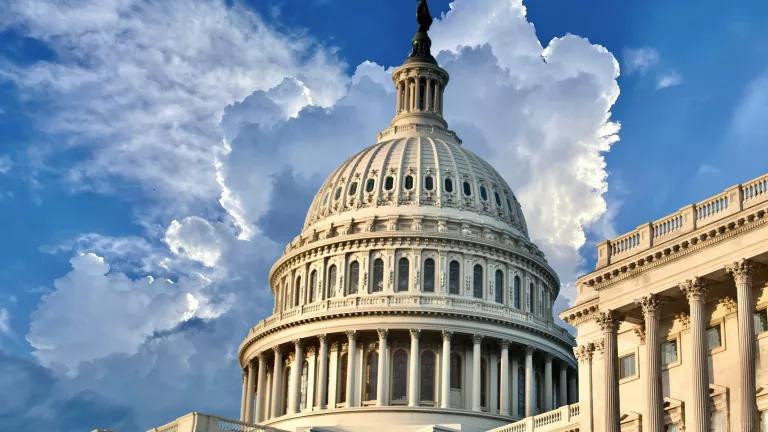To Avert Climate Catastrophe, Focus on Big, Proven Solutions

It’s easy to despair about the state of our fight against dangerous climate change. This season of devastating wildfires and hurricanes has been followed by a serious of ominous reports that drive home the “new abnormal” the world faces. But perhaps lost among these events and reports is the recent release of an important new book, Designing Climate Solutions by leading clean energy expert Hal Harvey, that suggests a simple formula as a solution.
In his book, Harvey does something remarkable: he clarifies that what looks like a complex, overwhelming challenge can actually be broken down into this formula: focus on the big solutions, in the biggest emitting countries, and the handful of the most effective, proven policy measures.
As the recently released Intergovernmental Panel on Climate Change and the 4th National Climate Assessment demonstrate, we should no longer be debating the science or arguing about timelines. Now is the time for serious action if we are to avoid the worst effects of climate change.
Fortunately, the mid-term elections have resulted in new, invigorated climate leadership at the state and federal levels. These new champions need to look no further than Designing Climate Solutions as well as NRDC’s recent clean energy plan to identify know the best policy levers to pull.
"Reducing global greenhouse gas emissions is no small task," Harvey writes. "But the technologies, policies, and motivation to achieve this reduction exist today."
The author points out that three-quarters of the world's greenhouse gas emissions come from just 20 countries, with the top seven (China, the U.S., India, Indonesia, Russia, Brazil, and Japan) emitting more than a gigaton of carbon dioxide equivalent per year.
The numbers point to what Harvey sees as a straightforward roadmap for reducing emissions from the energy and industrial sectors, which account for 93 percent of the total: "Implement policies that reduce emissions in the electricity, industry, transportation, and building sectors in the top 20 emitting countries."
Designing Climate Solutions lays out 10 policy types Harvey sees as the most effective. They include:
Renewable portfolio standards and feed-in tariffs
You guessed it: Ramping up solar and wind (and, by extension, displacing coal and natural gas) is key to slashing emissions from the power sector. But even though renewable energy prices are lower than ever, they won't grow quickly enough without the right policies—namely renewable portfolio standards that set regular production targets and feed-in tariffs that guarantee price and grid access. Harvey estimates these policies can contribute 10 percent of the cumulative global emissions cuts needed to keep temperature rise below 2 degrees Celsius, a baseline goal of the Paris climate agreement.
Vehicle performance standards
The U.S. has a steady, proven history of cutting emissions with fuel economy standards. In the past six years alone, they have helped avoid 242 million metric tons of carbon emissions, and they stand to save 6 billion tons by 2025. "Using vehicle performance standards is almost always smart policy," Harvey writes. "They save society money while driving down emissions." He adds, however, that standards leave gaps—older cars on the road, for example—and he advocates complementary measures such as fuel fees and policies that promote electric cars.
Building codes and appliance standards
Harvey recommends policies designed to make our homes, businesses and products more energy efficient. In the U.S., efficiency standards for appliances like refrigerators and clothes washers have helped avoid 3 billion tons of carbon pollution since the late 1980s, saving consumers $2 trillion on utility bills in the process. Commercial and residential buildings, Harvey points out, account for more than half the world's electricity use.
Industrial energy efficiency
Industrial activity accounts for more than 40 percent of the world's energy use. "But for unclear reasons," Harvey writes, "industrial energy and the policies affecting it aren’t discussed as often as transportation or electricity generation." He argues for a combination of eight key types of policies, including equipment standards, financial incentives, and mandatory targets, to help bring down industrial energy use and emissions. Tackling both industrial energy efficiency and the emissions from specific sources such as refrigerant use and methane leaks from natural gas systems would together meet more than a quarter of the emissions goal to help keep warming in check.
Carbon pricing
The main issue with carbon pricing policies so far, Harvey argues, is that the prices have been too low to achieve meaningful emissions reductions. Then, of course, there's the fact that most countries have no price on carbon whatsoever. While carbon pricing isn't a magic bullet, it's an important piece, he says, arguing for a hybrid approach that incorporates elements of cap-and-trade and a carbon tax.
There's nothing radical in these recommendations, all of which are proven, common-sense policy approaches, consistent with the NRDC report released last year, America's Clean Energy Frontier: A Pathway to a Safer Climate Future. Full confession: I’ve known Hal Harvey for almost my entire career working in the environmental field. I’ve found him to be master of what I call “de-complexification,” that is, simplifying complex problems.
And that’s exactly what the world needs now. Climate change can be an overwhelming problem, and as a result, paralyze exactly the people and leaders we need to galvanize into action. By bringing a clear-eyed certainty to what needs to be done, Hal Harvey’s ideas are an essential ingredient to catalyzing action to avert climate catastrophe.



